Abstract
Experiments were carried out in which the adrenergic neurone blocking activity of xylocholine, bretylium and guanethidine was studied by the use of the inhibitory responses of the isolated rabbit ileum to lumbar sympathetic nerve stimulation, and the contractions of the nictitating membrane of the anaesthetized cat in response to stimulation of the cervical sympathetic nerves. In both these preparations, after blockade of the effects of sympathetic nerve stimulation had been produced with xylocholine, bretylium or guanethicdine, the sympathomimetic amines, dexamphetamine, mephentermine, hydroxyamphetamine, ephedrine and phenethylamine, reversed the blockade; if these amines were given first, then the adrenergic neurone blocking agents were ineffective. Tyramine and dopamine were effective on the isolated rabbit ileum but not on the cat's nictitating membrane. Effective antagonism of the adrenergic neurone blocking drugs was also shown by some substances which inhibit mono-amine oxidase but only those which in addition possess sympathomimetic effects. Thus phenelzine, pheniprazine and tranylcypromine were effective whereas iproniazid and nialamide were not. Since xylocholine, bretylium and guanethidine were all antagonized by the same agents, it seems likely that they all produce sympathetic blockade by a similar mechanism. The possibility is discussed that the sympathomimetic amines which antagonize the adrenergic neurone blocking drugs are competing with these substances for the same receptor sites.
Full text
PDF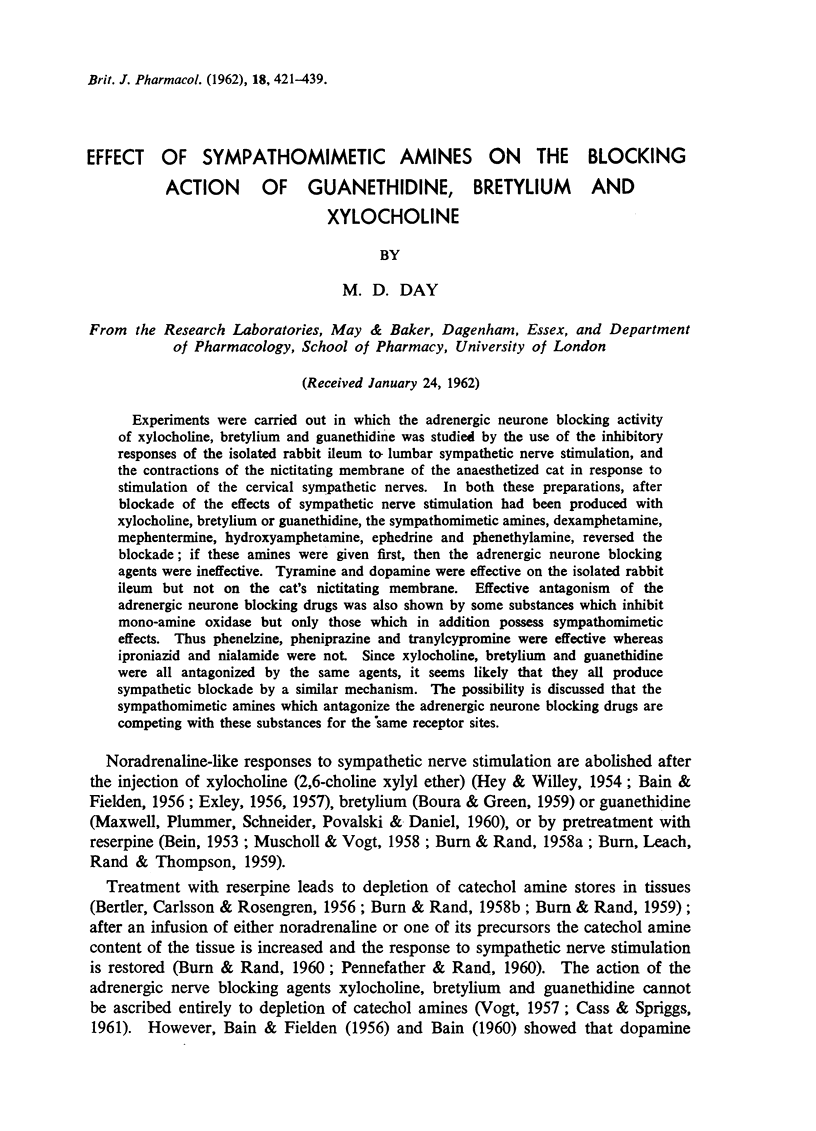
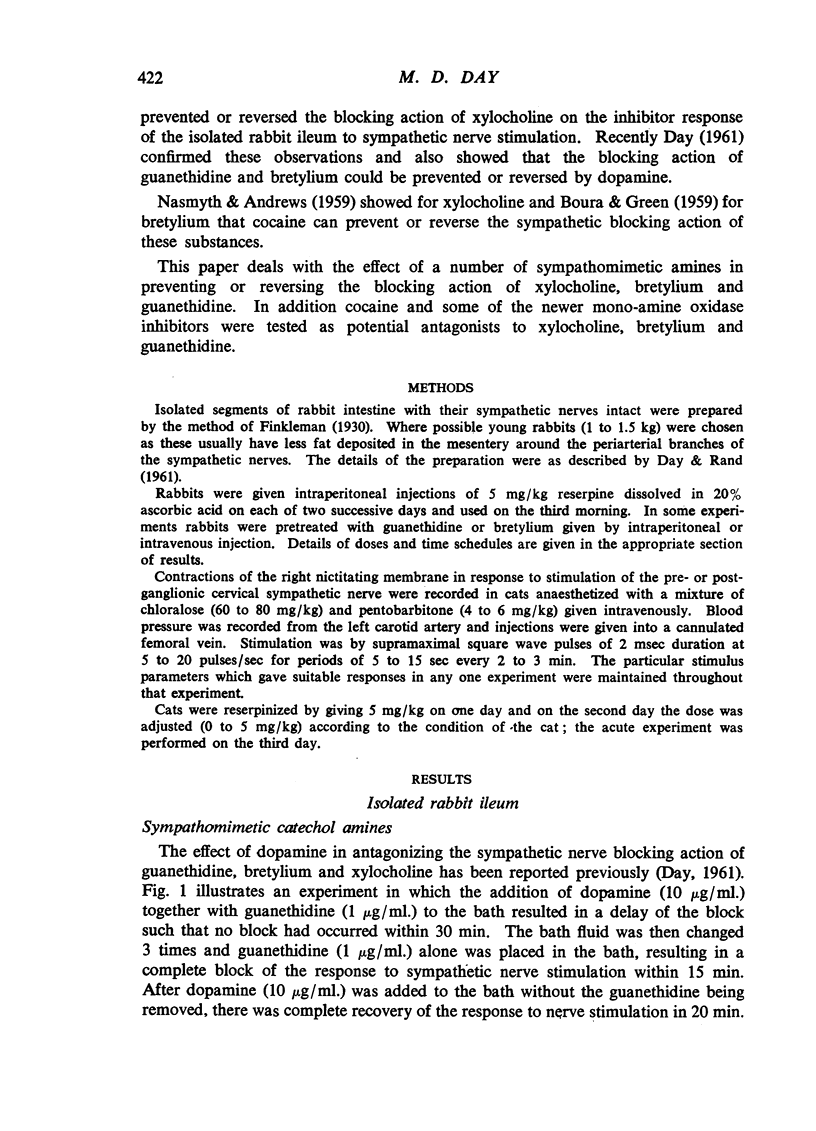
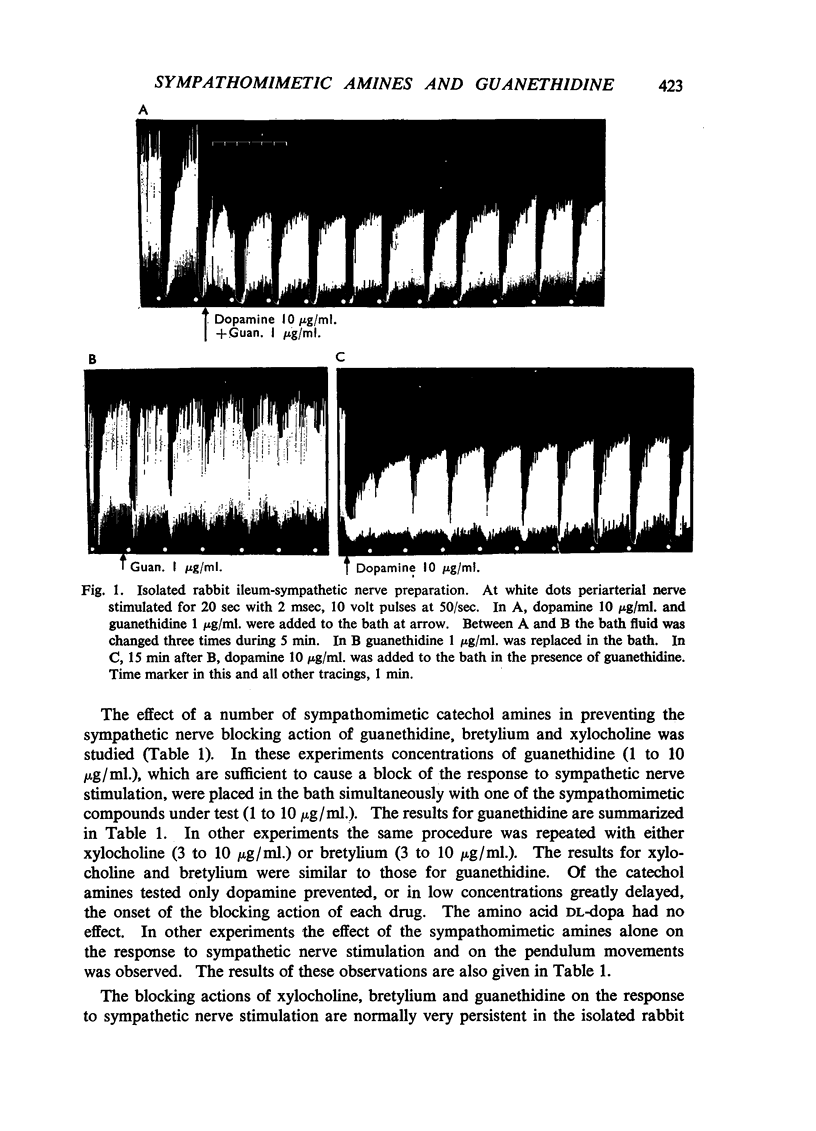

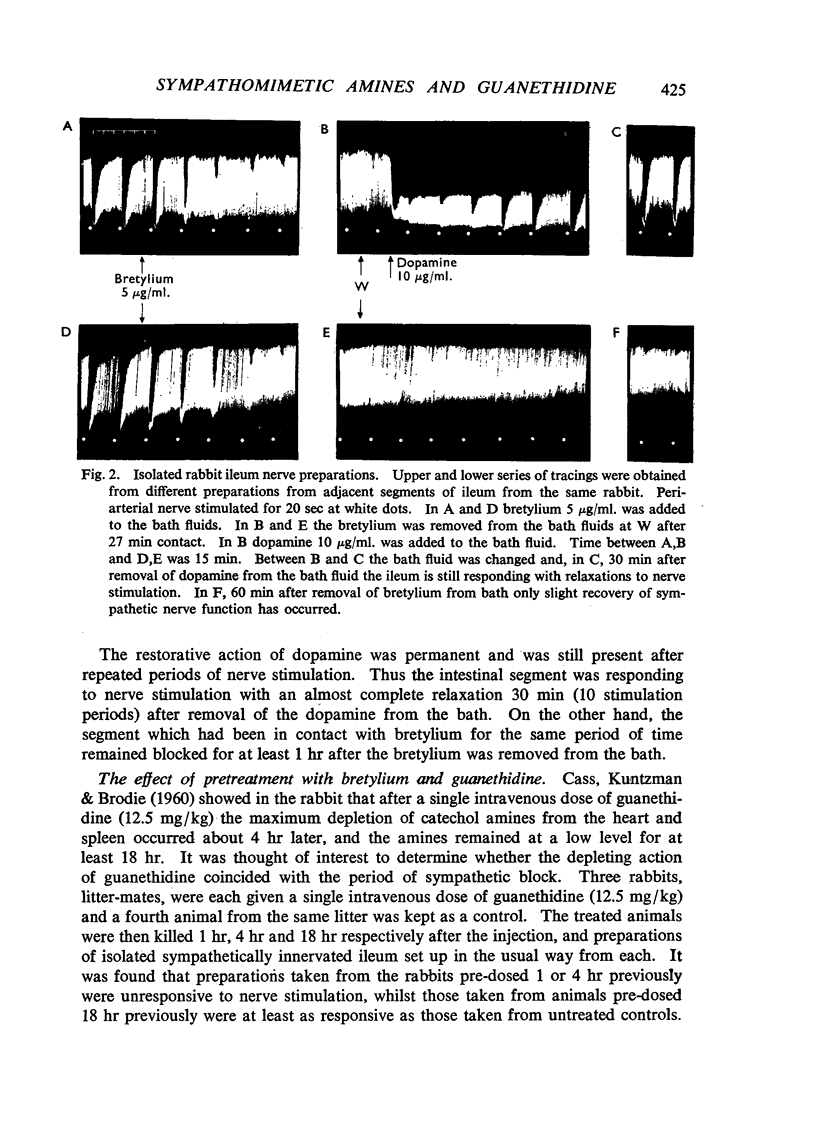
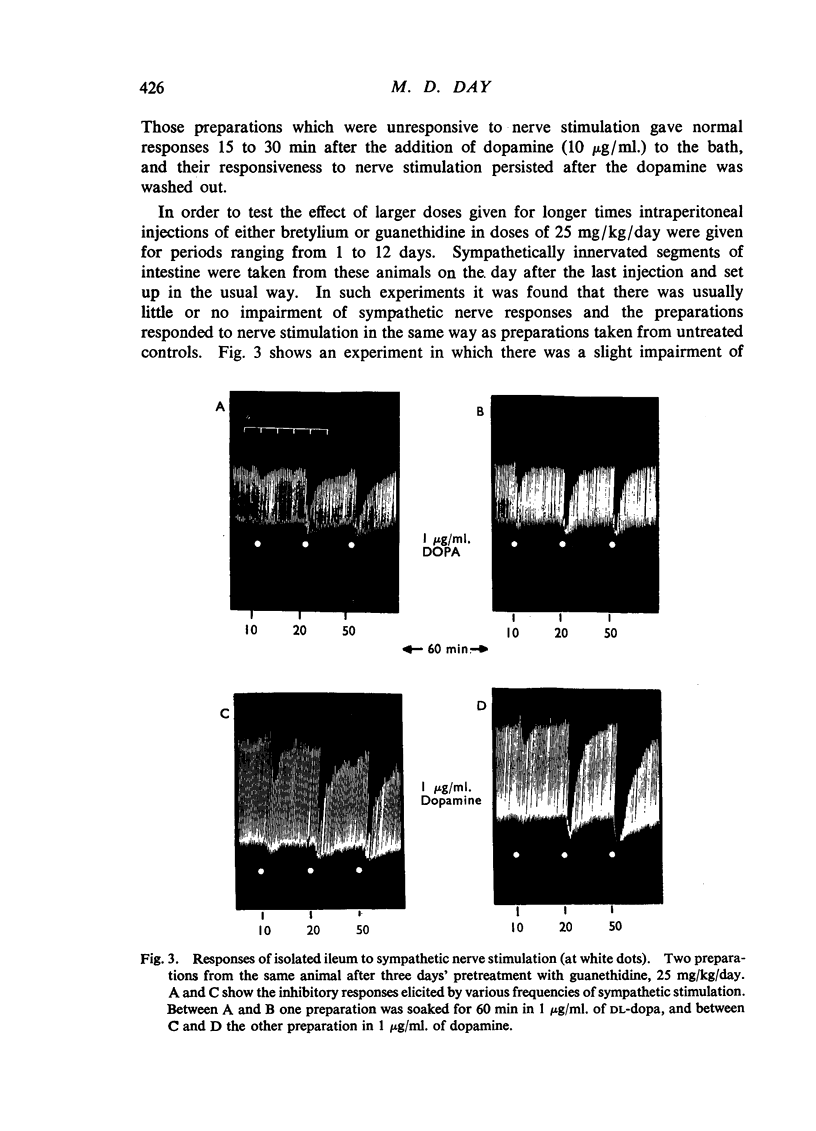
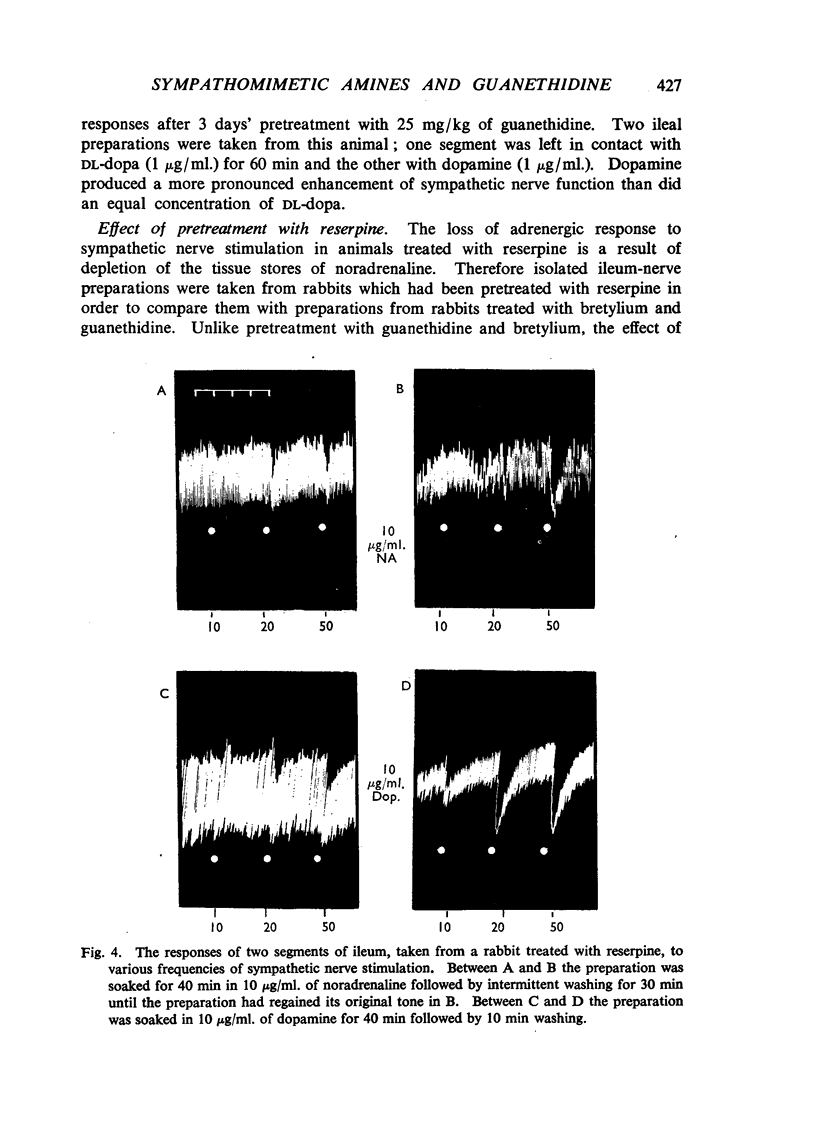
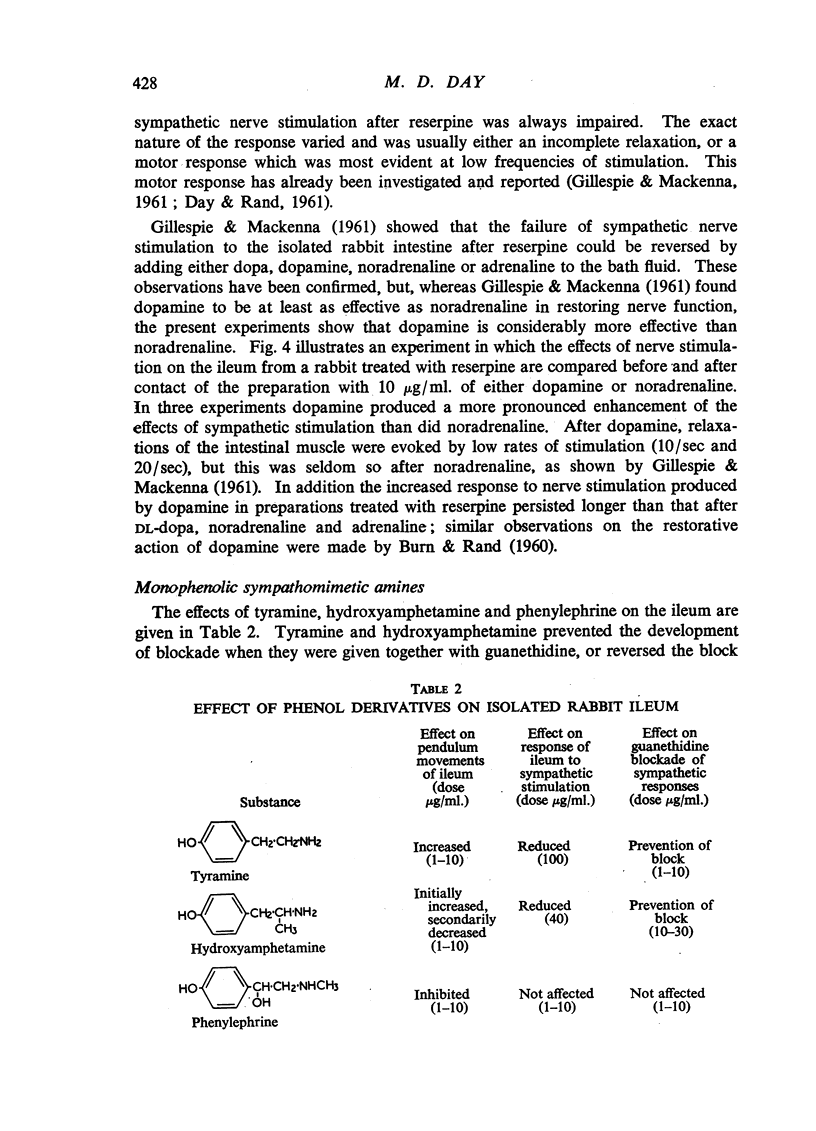
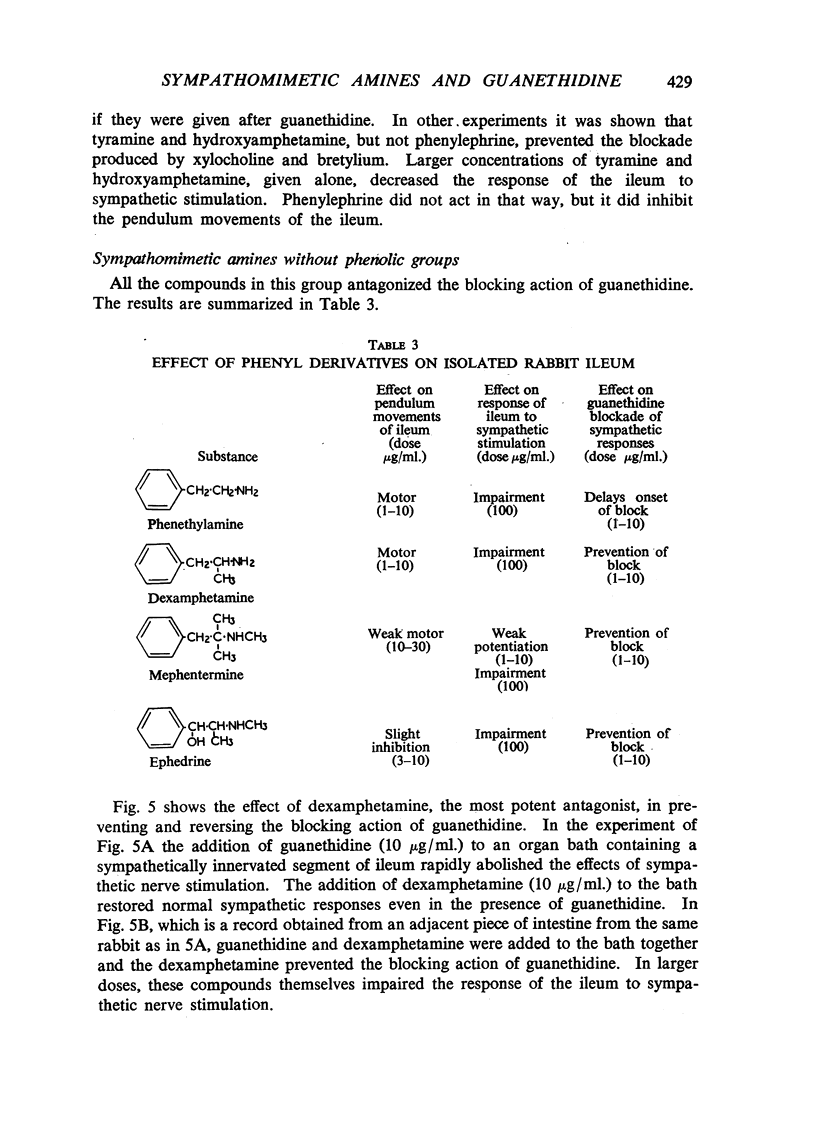

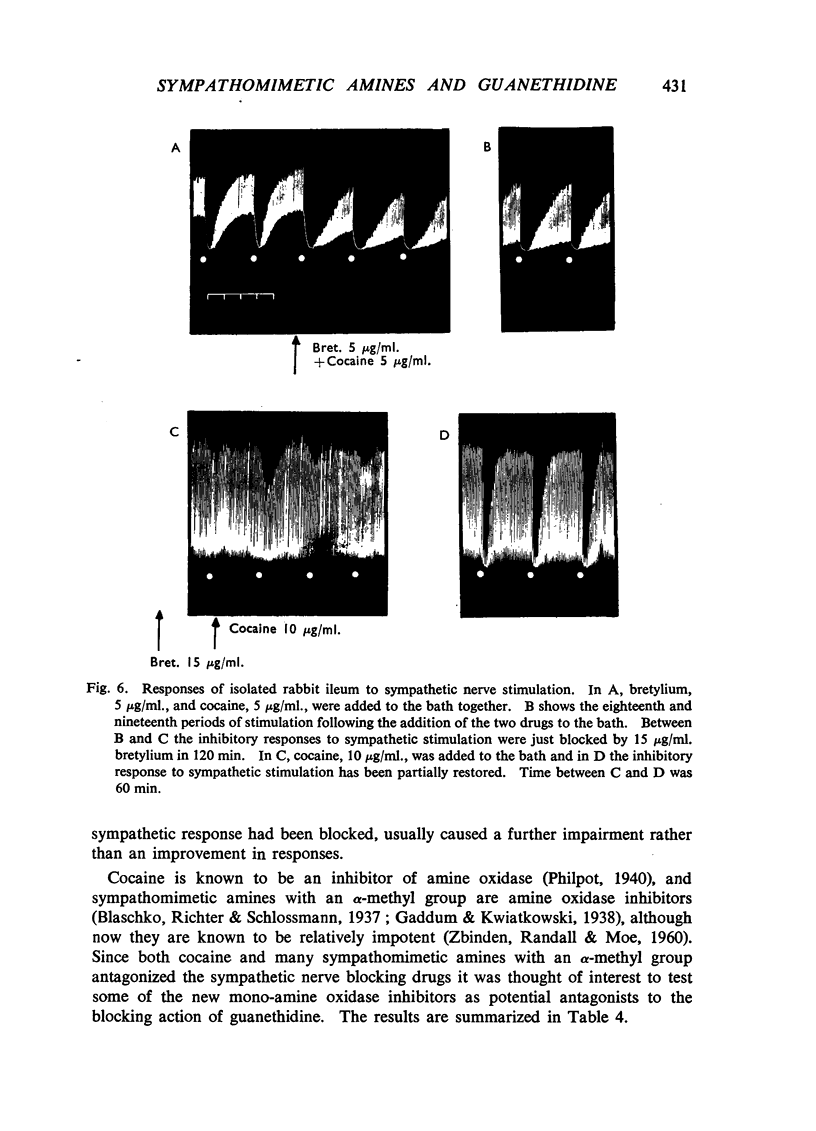
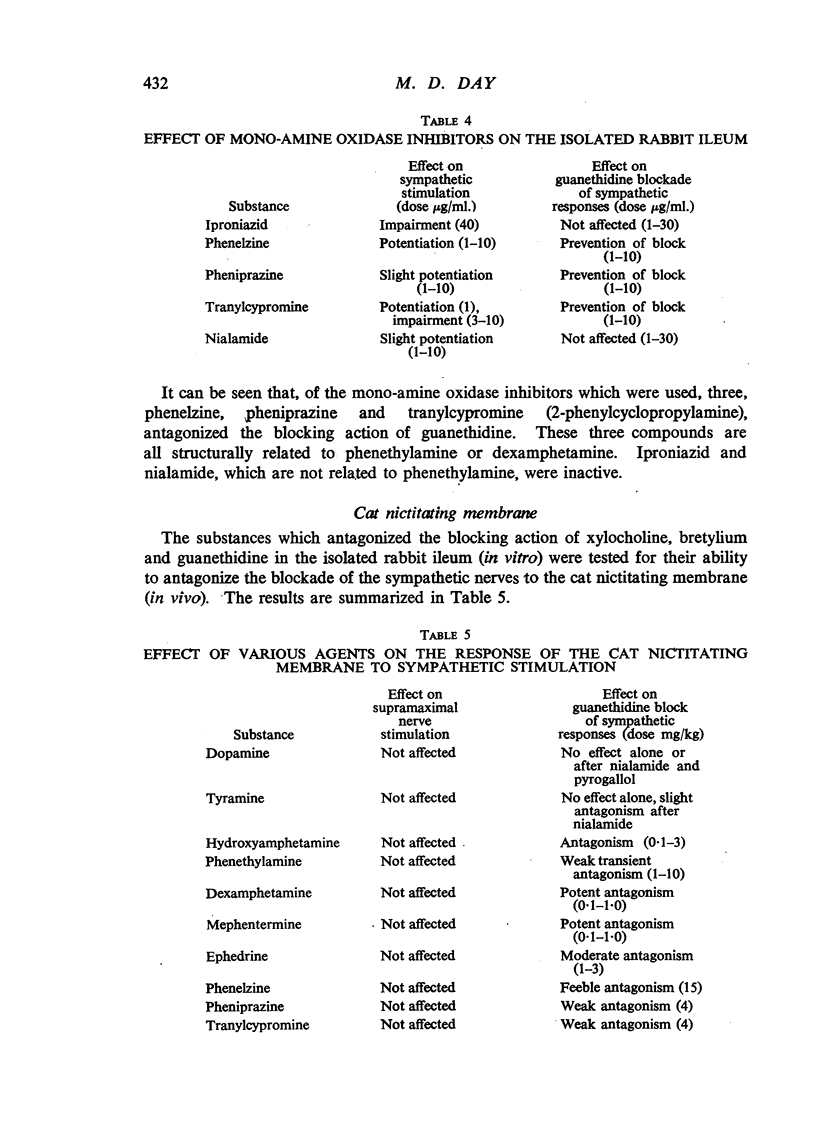

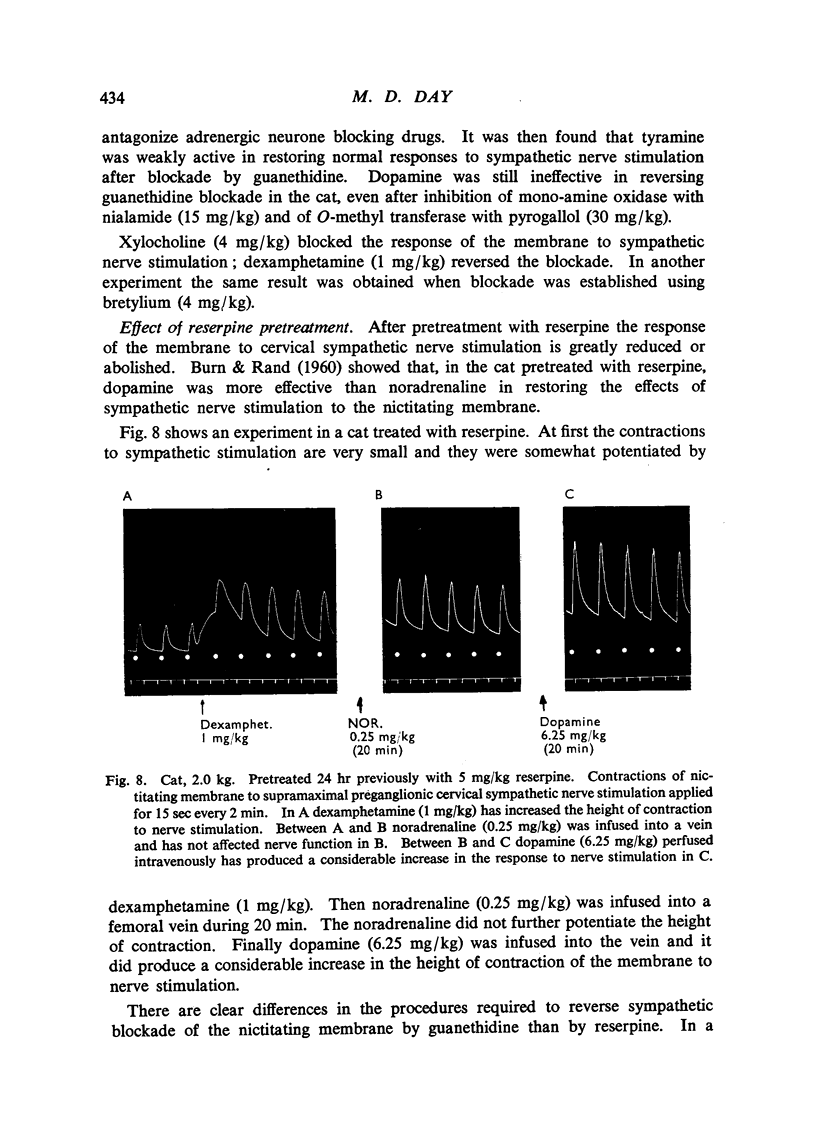
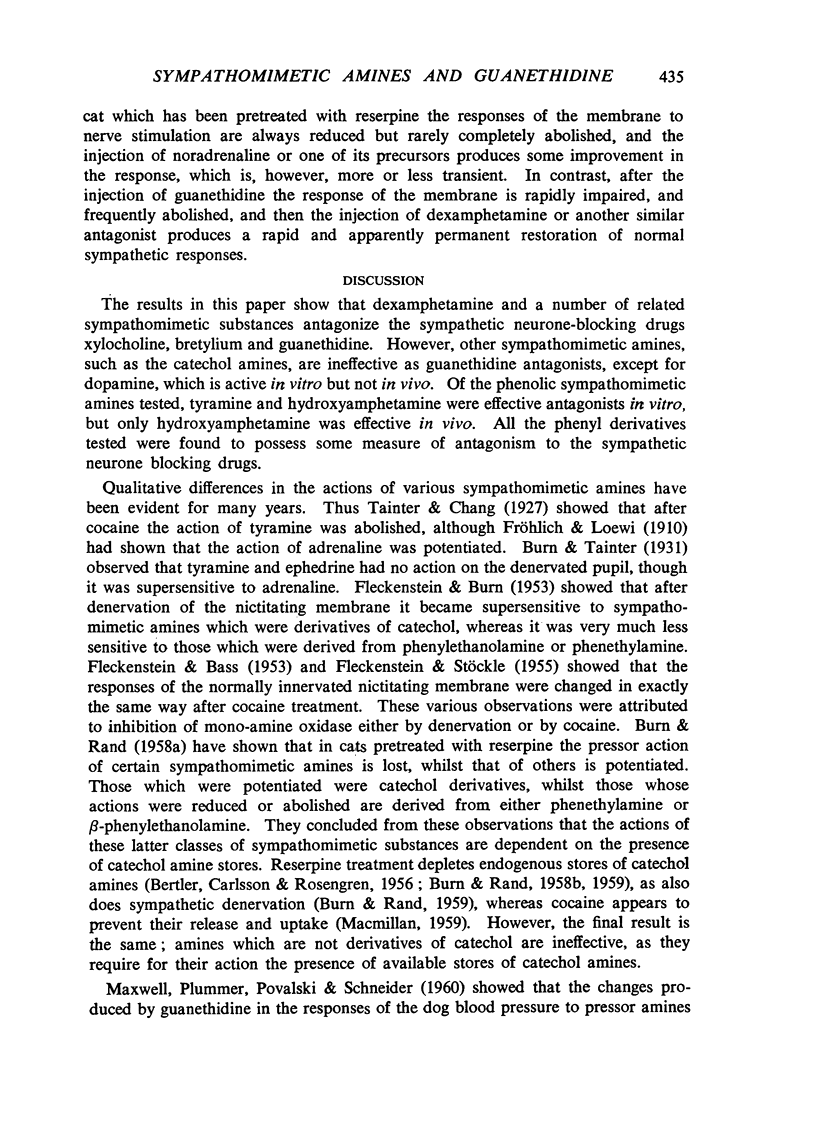
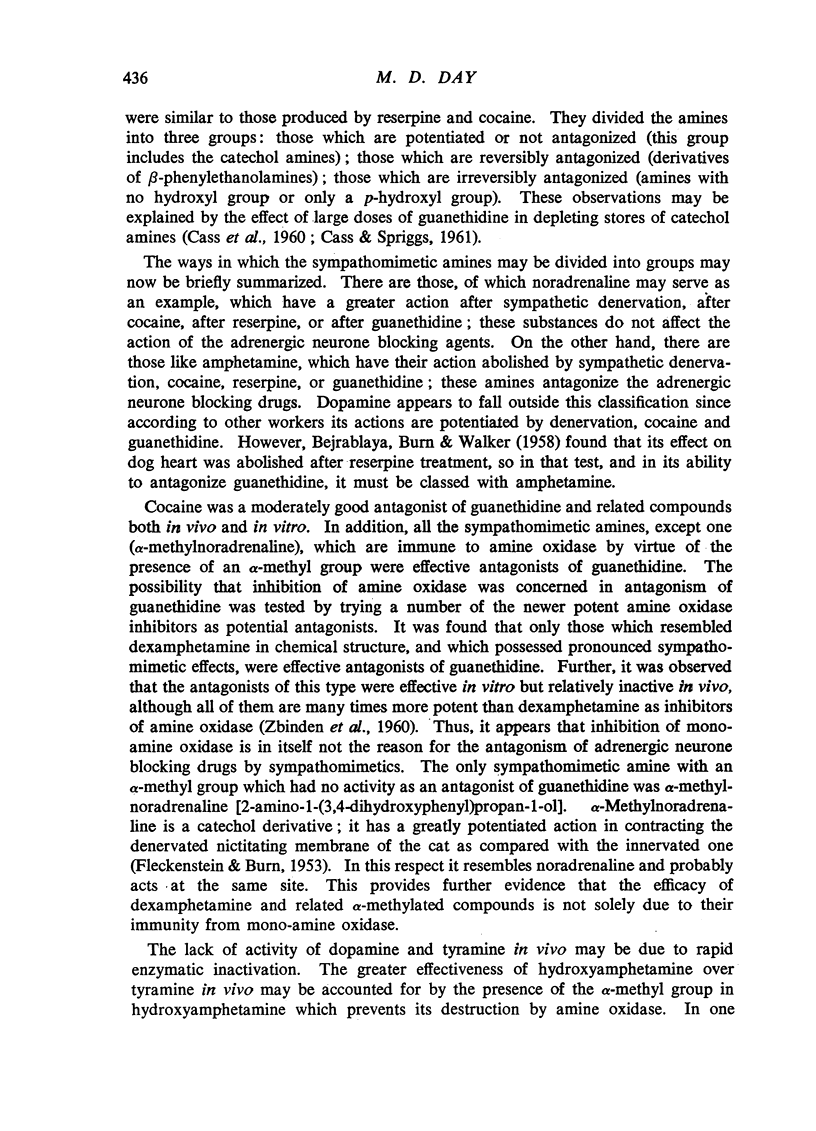
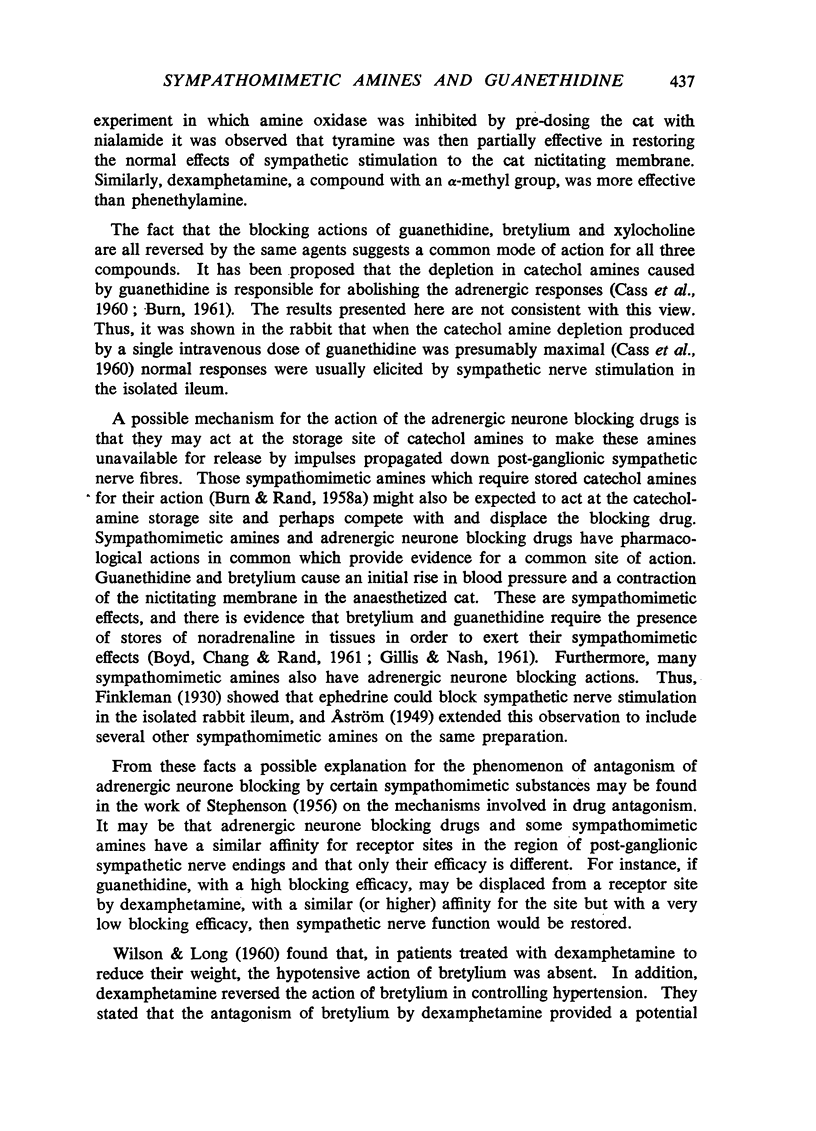
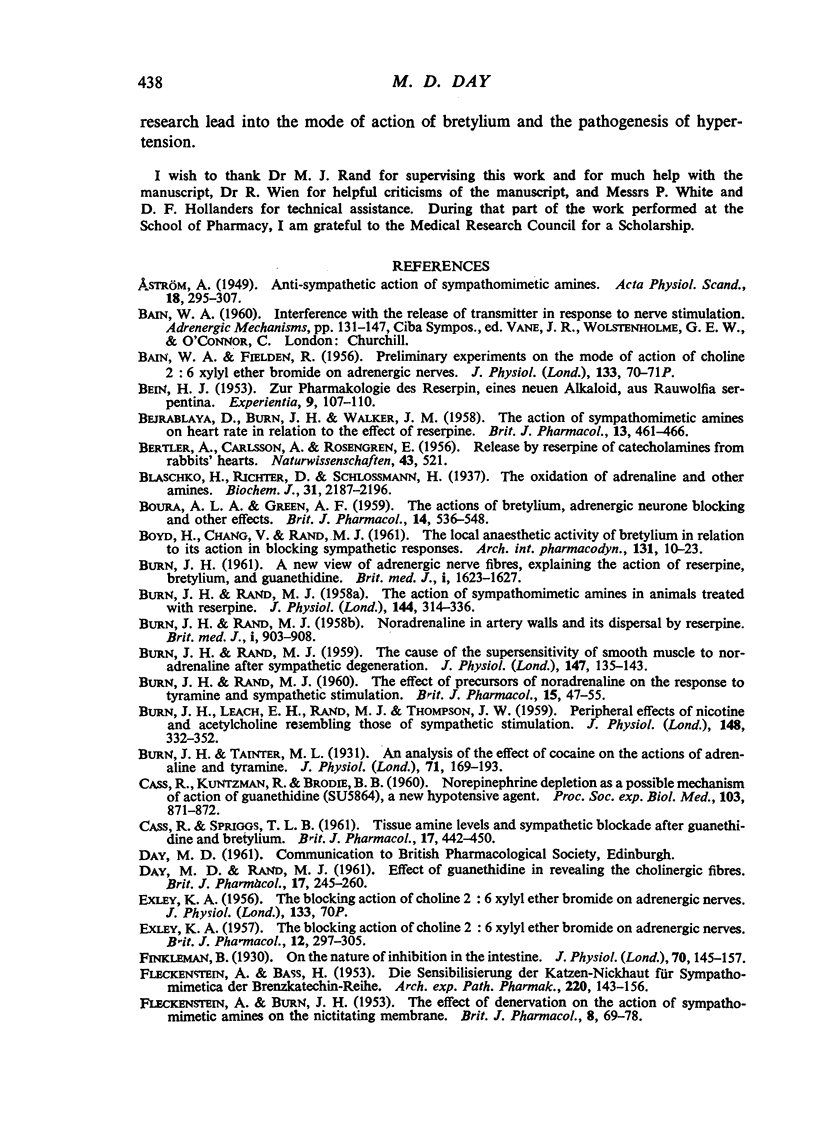
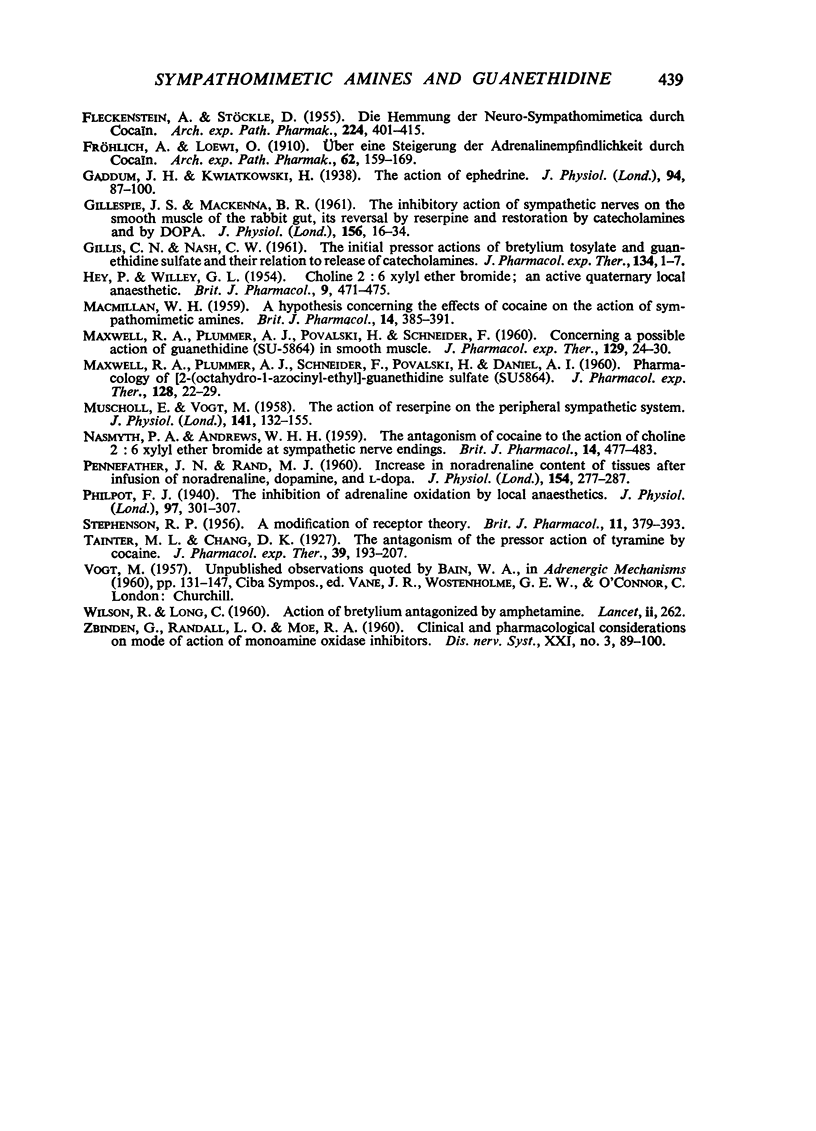
Selected References
These references are in PubMed. This may not be the complete list of references from this article.
- BEIN H. J. Zur Pharmakologie des Reserpin, eines neuen Alkaloids aus Rauwolfia serpentina Benth. Experientia. 1953 Mar 15;9(3):107–110. doi: 10.1007/BF02178342. [DOI] [PubMed] [Google Scholar]
- BEJRABLAYA D., BURN J. H., WALKER J. M. The action of sympathomimetic amines on heart rate in relation to the effect of reserpine. Br J Pharmacol Chemother. 1958 Dec;13(4):461–466. doi: 10.1111/j.1476-5381.1958.tb00238.x. [DOI] [PMC free article] [PubMed] [Google Scholar]
- BOURA A. L., GREEN A. F. The actions of bretylium: adrenergic neurone blocking and other effects. Br J Pharmacol Chemother. 1959 Dec;14:536–548. doi: 10.1111/j.1476-5381.1959.tb00961.x. [DOI] [PMC free article] [PubMed] [Google Scholar]
- BURN J. H. A new view of adrenergic nerve fibres, explaining the action of reserpine, bretylium, and guanethidine. Br Med J. 1961 Jun 10;1(5240):1623–1627. doi: 10.1136/bmj.1.5240.1623. [DOI] [PMC free article] [PubMed] [Google Scholar]
- BURN J. H., LEACH E. H., RAND M. J., THOMPSON J. W. Peripheral effects of nicotine and acetylcholine resembling those of sympathetic stimulation. J Physiol. 1959 Oct;148:332–352. doi: 10.1113/jphysiol.1959.sp006291. [DOI] [PMC free article] [PubMed] [Google Scholar]
- BURN J. H., RAND M. J. Noradrenaline in artery walls and its dispersal by reserpine. Br Med J. 1958 Apr 19;1(5076):903–908. doi: 10.1136/bmj.1.5076.903. [DOI] [PMC free article] [PubMed] [Google Scholar]
- BURN J. H., RAND M. J. The action of sympathomimetic amines in animals treated with reserpine. J Physiol. 1958 Dec 4;144(2):314–336. doi: 10.1113/jphysiol.1958.sp006104. [DOI] [PMC free article] [PubMed] [Google Scholar]
- BURN J. H., RAND M. J. The cause of the supersensitivity of smooth muscle to noradrenaline after sympathetic degeneration. J Physiol. 1959 Jun 23;147(1):135–143. doi: 10.1113/jphysiol.1959.sp006228. [DOI] [PMC free article] [PubMed] [Google Scholar]
- BURN J. H., RAND M. J. The effect of precursors of noradrenalin on the response to tyramine and sympathetic stimulation. Br J Pharmacol Chemother. 1960 Mar;15:47–55. doi: 10.1111/j.1476-5381.1960.tb01209.x. [DOI] [PMC free article] [PubMed] [Google Scholar]
- Blaschko H., Richter D., Schlossmann H. The oxidation of adrenaline and other amines. Biochem J. 1937 Dec;31(12):2187–2196. doi: 10.1042/bj0312187. [DOI] [PMC free article] [PubMed] [Google Scholar]
- Burn J. H., Tainter M. L. An analysis of the effect of cocaine on the actions of adrenaline and tyramine. J Physiol. 1931 Feb 25;71(2):169–193. doi: 10.1113/jphysiol.1931.sp002724. [DOI] [PMC free article] [PubMed] [Google Scholar]
- CASS R., KUNTZMAN R., BRODIE B. B. Norepinephrine depletion as a possible mechanism of action of guanethidine (SU 5864), a new hypotensive agent. Proc Soc Exp Biol Med. 1960 Apr;103:871–872. doi: 10.3181/00379727-103-25702. [DOI] [PubMed] [Google Scholar]
- CASS R., SPRIGGS T. L. Tissue amine levels and sympathetic blockade after guanethidine and bretylium. Br J Pharmacol Chemother. 1961 Dec;17:442–450. doi: 10.1111/j.1476-5381.1961.tb01131.x. [DOI] [PMC free article] [PubMed] [Google Scholar]
- DAY M. D., RAND M. J. Effect of guanethidine in revealing cholinergic sympathetic fibres. Br J Pharmacol Chemother. 1961 Oct;17:245–260. doi: 10.1111/j.1476-5381.1961.tb01285.x. [DOI] [PMC free article] [PubMed] [Google Scholar]
- EXLEY K. A. The blocking action of choline 2:6-xylyl ether bromide on adrenergic nerves. Br J Pharmacol Chemother. 1957 Sep;12(3):297–305. doi: 10.1111/j.1476-5381.1957.tb00138.x. [DOI] [PMC free article] [PubMed] [Google Scholar]
- FLECKENSTEIN A., BASS H. Zum Mechanismus der Wirkungsverstärkung und Wirkungsabschwächung sympathomimetischer Amine durch Cocain und andere Pharmaka. I. Die Sensibilisierung der Katzen-Nickhaut für Sympathomimetica der Brenzkatechin-Reihe. Naunyn Schmiedebergs Arch Exp Pathol Pharmakol. 1953;220(1-2):143–156. [PubMed] [Google Scholar]
- FLECKENSTEIN A., BURN J. H. The effect of denervation on the action of sympathomimetic amines on the nictitating membrane. Br J Pharmacol Chemother. 1953 Mar;8(1):69–78. doi: 10.1111/j.1476-5381.1953.tb00754.x. [DOI] [PMC free article] [PubMed] [Google Scholar]
- FLECKENSTEIN A., STOCKLE D. Zum Mechanismus der Wirkungs-Verstärkung und Wirkungs-Abschwächung sympathomimetischer Amine durch Cocain und andere Pharmaka. II. Die Hemmung der Neuro-Sympathomimetica durch Cocain. Naunyn Schmiedebergs Arch Exp Pathol Pharmakol. 1955;224(5-6):401–415. [PubMed] [Google Scholar]
- Finkleman B. On the nature of inhibition in the intestine. J Physiol. 1930 Sep 18;70(2):145–157. doi: 10.1113/jphysiol.1930.sp002683. [DOI] [PMC free article] [PubMed] [Google Scholar]
- GILLESPIE J. S., MACKENNA B. R. The inhibitory action of the sympathetic nerves on the smooth muscle of the rabbit gut, its reversal by reserpine and restoration by catechol amines and by DOPA. J Physiol. 1961 Apr;156:17–34. doi: 10.1113/jphysiol.1961.sp006655. [DOI] [PMC free article] [PubMed] [Google Scholar]
- GILLIS C. N., NASH C. W. The initial pressor actions of bretylium tosylate and guanethidine sulfate and their relation to release of catecholamines. J Pharmacol Exp Ther. 1961 Oct;134:1–7. [PubMed] [Google Scholar]
- Gaddum J. H., Kwiatkowski H. The action of ephedrine. J Physiol. 1938 Oct 14;94(1):87–100. doi: 10.1113/jphysiol.1938.sp003664. [DOI] [PMC free article] [PubMed] [Google Scholar]
- HEY P., WILLEY G. L. Choline 2 : 6-xylyl ether bromide; an active quaternary local anaesthetic. Br J Pharmacol Chemother. 1954 Dec;9(4):471–475. doi: 10.1111/j.1476-5381.1954.tb00863.x. [DOI] [PMC free article] [PubMed] [Google Scholar]
- MACMILLAN W. H. A hypothesis concerning the effect of cocaine on the action of sympathomimetic amines. Br J Pharmacol Chemother. 1959 Sep;14:385–391. doi: 10.1111/j.1476-5381.1959.tb00263.x. [DOI] [PMC free article] [PubMed] [Google Scholar]
- MAXWELL R. A., PLUMMER A. J., SCHNEIDER F., POVALSKI H., DANIEL A. I. Pharmacology of [2-(octahydro-1-azocinyl)-ethyl]-guanidine sulfate (Su-5864). J Pharmacol Exp Ther. 1960 Jan;128:22–29. [PubMed] [Google Scholar]
- MUSCHOLL E., VOGT M. The action of reserpine on the peripheral sympathetic system. J Physiol. 1958 Apr 3;141(1):132–155. doi: 10.1113/jphysiol.1958.sp005961. [DOI] [PMC free article] [PubMed] [Google Scholar]
- NASMYTH P. A., ANDREWS W. H. The antagonism of cocaine to the action of choline 2,6-xylyl ether bromide at sympathetic nerve endings. Br J Pharmacol Chemother. 1959 Dec;14:477–483. doi: 10.1111/j.1476-5381.1959.tb00951.x. [DOI] [PMC free article] [PubMed] [Google Scholar]
- PENNEFATHER J. N., RAND M. J. Increase in noradrenaline content of tissues after infusion of noradrenaline, dopamine and L-DOPA. J Physiol. 1960 Dec;154:277–287. doi: 10.1113/jphysiol.1960.sp006579. [DOI] [PMC free article] [PubMed] [Google Scholar]
- Philpot F. J. The inhibition of adrenaline oxidation by local anaesthetics. J Physiol. 1940 Jan 15;97(3):301–307. doi: 10.1113/jphysiol.1940.sp003808. [DOI] [PMC free article] [PubMed] [Google Scholar]
- STEPHENSON R. P. A modification of receptor theory. Br J Pharmacol Chemother. 1956 Dec;11(4):379–393. doi: 10.1111/j.1476-5381.1956.tb00006.x. [DOI] [PMC free article] [PubMed] [Google Scholar]
- ZBINDEN G., RANDALL L. O., MOE R. A. Clinical and pharmacological considerations on mode of action of monoamine oxidase inhibitors. Dis Nerv Syst. 1960 Mar;21(3):89–100. [PubMed] [Google Scholar]


